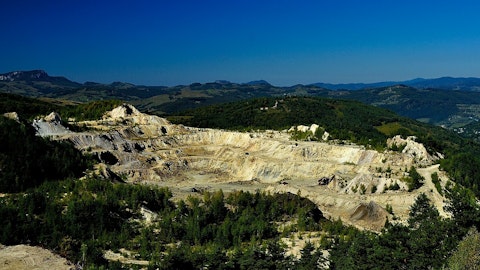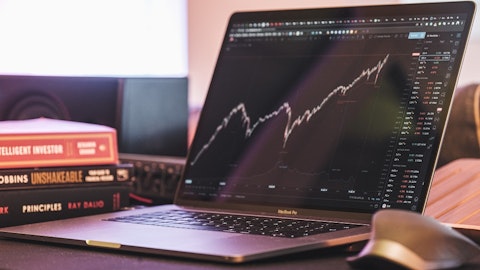But now I would actually add is another piece of that theme, which is a remilitarization along with the globalization. And I think we see that certainly in unfortunately, the procurement that must happen around weapons globally. And so that trend, I think – and obviously, that’s just beginning, but I think you have to think about whether it’s robotics, guided missiles, some of these other things that, that actually is going to be a significant source of demand in the coming couple of years. And I think that that’s actually a kind of demand that will favor our supply chain for obvious reasons. And then lastly, I probably should have touched on this with respect to electrification and slowing down – perception of slowing down because the interest rates are higher and there is some weakness.
But you saw a big announcement from Toyota recently about investing more in hybrids. And let’s not forget that if we do go into a world where hybrids have higher penetration along the way to electrification, hybrids typically utilize two-thirds of the amount of incremental NdPr that say a straight EV would use. And so that’s also just bullish for growth relative to just slower penetration. So anyway, adding all of that up, what I would say is we’re – certainly, I think that the bottom, I called several months ago, remains intact. I think that the short-term, the economy is challenged. I think people are very nervous. So who knows what the next couple of months look like. But all of those trends are very bullish for a year or 2 out, particularly the remilitarization, which is a totally new theme that I think is going to is going to become very powerful in the capital markets in 2024.
George Gianarikas: Maybe just as a quick follow-up to then, thank you. Can you kind of illuminate us as to what your production cost per kilogram will be as you reach steady-state production for NdPr?
Ryan Corbett: Sure. George, it’s Ryan. I’ll take that one. Certainly, with our initial production this quarter and ramping that as quickly as possible and as profitably as possible, it’s a little bit early to home in on exactly what cost per kilogram will be given where we are right now. What we want to do is see operations at full scale, efficient run rate production before we start making other promises here. What I would say, though, is when we went public, we gave some rough guidelines on our expected cost of production at that point. And as you can imagine, at that point, those numbers were based on an amount of estimate as to exactly how the chemistry would work in the plant. And so I think what I’ve talked about in prior calls is we see there, we’re very, very pleased with.
So we think our assumptions there will prove correct or conservative. The other thing to keep in mind, though, is Stage 2, in particular, on a variable cost basis is heavily dependent on commodity reagents. And those have seen pretty significant price increases as labor and energy. And so our hope is that as we get up and running and add scale and efficiency that those eventually offset each other, but it’s a little bit early days to give more definitive information at this point. However, I would close by saying with everything that we have seen to-date, we remain confident in our ability to maintain our position as a low-cost producer in this industry.
George Gianarikas: Thank you.
Operator: Thank you. The next question is from the line of Abhishek Sinha with Northland Capital Markets. You may proceed.
Unidentified Analyst: Hi. This is Kailash on behalf of Abhishek Sinha. So, we saw the recent news on Malaysia’s export of metals, and we just wanted to know what your outlook is on that and if you sort of want to ramp up production based on that supply squeeze.
Jim Litinsky: Well, the Malaysia news, I think just had to do – I think there are still a lot of headlines. I think actually, the Malaysia news had to do with the Malaysian Government wanting to capture more of the value chain. Aside from just sending some material, they wanted to kind of have actually more of the industry. But obviously, we don’t operate in Malaysia. That really doesn’t impact how we think about things over state side right now, we’re – so I really see no impact with respect to us from that.
Unidentified Analyst: Sure. As a follow-up, we just wanted to know what premiums you sort of experienced with NdPr oxides over NdPr ore?
Jim Litinsky: I am sorry, can you repeat that?
Unidentified Analyst: We are curious to know what premium you experienced for NdPr oxides over NdPr ore.
Jim Litinsky: Got it. Yes. I assume you are talking about sort of the bridge from concentrate to oxide. I think the way we think about the uplift in moving to separation is it’s not just a focus on the price and the revenue side. The focus for us, obviously, is on incremental margin dollars. And so obviously, both con and oxide are quoted in the market. And so you guys can kind of do the math there. But as we ramp the plant, and get what we expect to be a fairly insisting cost of production once we hit target levels, the amount of NdPr in our con is about 15.7%. And so you can sort of do the math there on expected cost of production for the oxide versus con. But putting that all together, we are very pleased with what we expect to be a nice uplift in both revenue and profit dollars as we move to separation.
Unidentified Analyst: Thanks. That’s helpful.
Operator: Thank you. The next question is from the line of Corinne Blanchard with Deutsche Bank. You may proceed.
Corinne Blanchard: Hey. Good afternoon guys. Could you maybe talk about the shipment time and delivery time for the NdPr oxide and the timing of when revenue would be recognized for the shipment?
Ryan Corbett: Sure. Hey Corinne, it’s Ryan. I will take that. I would refer you back to our comments in the last call and what we talked about a little bit earlier, which is that these initial shipments of oxide, particularly the Q3 production as well as early Q4 production, we are prioritizing building an inventory level in the tolling channel. In order for tolling to start in earnest, there needs to be a visibility to consistent inventory on site to get the electro winning process started and running efficiently. And so what that causes for us is given the fact that we maintain title of the oxide all the way through the production of metal, it really just slows the recognition of revenue because we will sell it for our purposes once it is turned into metal and at the port or location of delivery after being converted.



